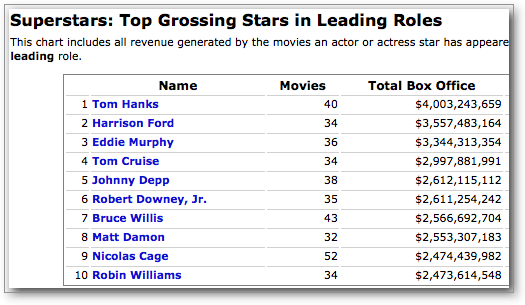Analysis: Superstars, Side Kicks and Cameo Kings
September 14, 2013
Over the past two or so years, we've been working on one of the biggest projects we've ever undertaken: building out our database of acting and technical credits to include complete information on every acting role and significant technical credit for movies for which we have box office information. While work on this vast task continues (and will, of course, continue as long as films are being made), we have enough coverage of the industry now to start doing some serious analysis. Over the next month or two, I'll be looking at some of the things we've found and we'll be rolling out new features at The Numbers that take advantage of the dataset. This week, I'll look into how we are categorizing acting roles, and discuss the first charts in our new People Records section.
Every acting credit that we enter into the database now comes with nine attributes, as shown in the example below:
The first few attributes, the film, the person and the character name, are pretty obvious. The rest could use some explanation.
We classify a Role Type as leading if the character appears in the poster for the film. If there are more than four people (or animated characters) on the poster, then we consider the film an ensemble piece, and the people on the poster are "lead ensemble members." We also have special cases for cameos, documentary subjects and interviewees, and for bit parts and uncredited roles as extras. In all other cases the Role Type is "supporting."
The Above the Line field indicates whether a credit is above the line or not. Above the line credits are the names that appear one by one on the screen during the opening (or sometimes closing) credits for a film. They also appear in the spidery writing at the bottom of the film's poster. And they're a big deal to all concerned. Above the line parts are generally the key roles in a film and form the center of casting decisions and budget negotiations. So they're a really good indication that someone is a sought-after actor (for this particular film, at least).
Voice Only, as one might expect, indicates whether someone actually appears on the screen, or only their voice is heard. Obviously roles in animated films are voice-only roles, but so are some roles in live action films.
The Billing attribute allows us to order the credits when we present them, and is another indicator of the relative importance of a role. We start with the above the line credits (in the order they appear on screen), and then follow the order in the credits that scroll by at the end of the film.
Finally, we have a record of any Oscar nominations or wins for this role and the name under which the person was credited.
We've now been through this process for just under 100,000 acting roles (and something over 50,000 technical credits, which I'll talk about next week). More are being added every day, and I'd encourage anyone with credits in films with reported box office to fire us a line if you can't find your credit listed on the site. We use the official credit list for the film to enter the data, so sending that across with your email would be particularly helpful. corrections@the-numbers.com

Top-grossing actors and actresses in leading roles

Jennifer Lawrence's credit for Catching Fire
Filed under: Analysis, Harry Potter, Robert De Niro, Harrison Ford, Morgan Freeman, Tom Hanks, Samuel L. Jackson, Gary Oldman, Warwick Davis, Robert Downey, Jr., Stan Lee, Michael Papajohn, John Ratzenberger, Frank Welker


